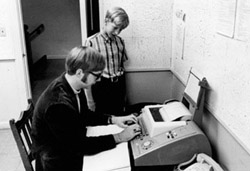
The time you and Bill Gates spent at Lakeside School exploring the world of computers has already achieved the status of legend. But what isn't as clear are the UW-related facilities you took advantage of during that time. For example, four UW faculty and staff created the Computer Center Corporation (known as "C-Cubed") on Roosevelt Way, which you and your Lakeside friends helped debug. The center had one of the first commercially available, time-sharing PDP-10 computers in the nation and the owners gave you free computer time to find all the flaws in the system. In one interview you recalled how you would often ride the bus to the U District, stay at the computer center and then eat pizza at Morningtown Pizza on 41st and Roosevelt. Are these tales pretty accurate?
A. Yes. These are accurate. As many people know, back in the early '70s I would come over to campus and sneak into the graduate computer center at Roberts Hall to get some time and experience on the machines. Eventually Bill and some other guys from Lakeside came over too. I eventually got caught by an assistant professor in the lab—he didn't recognize me from any of his classes, and I had to admit I wasn't a UW student either. But he knew that we had been helping other students, so he told us that if we helped people while we were here, we could stick around. We were thrilled at the opportunity and although we were just high-school students, it was so cool to be on campus, working alongside college students, and exploring our new passion for computers, which were still such a novelty. We eventually wore out our welcome but it was a really transformative and positive experience to have that opportunity.

Bill Gates, an eight-grader, looks over the shoulder of Paul Allen, a tenth-grader, in this 1968 photo taken at the Lakeside School's computer desk. Photo courtesy of Lakeside School.
One of your assignments was to try to crash the PDP-10. Was it a game for you and the others--trying to see how quickly you could bring the machine down?
Crashing the PDP-10 was at Computer Center Corp., off-campus. We just tried to figure out things that caused the system to crash, so that we would be able to keep using the machines for our own experimental projects (it's how we earned extra time for ourselves). I think we also did crash the [Burroughs] B-5500 in Roberts Hall a few times as well.
I've also read that you tried to understand the inner workings of the PDP-10 and that the C-Cubed programmers would only give you one manual at a time.
They basically spoon-fed me one manual at a time to see what would happen, but I really gobbled them up, and was soon doing system programming in assembly language on the BASIC compiler, and that was just at the age of 17.
Wasn't this a difficult way to learn about computers?
I think that given the options at the time, the most effective way to learn was going hands-on with what was the top machine at the time, learning about how it worked, what it took to "make it or break it." I think people learn best by being hands-on, whether it's exploring computers, learning to play music, etc.
Today we have amazing resources available, and the commitment to computer science represented by this building (the Paul G. Allen Center for Computer Science and Engineering) will result in advancements we can barely imagine now—and a large part of it is about having more lab space and computers that young people can get their own experience on. In the way that we could not conceive of how computers would change our lives, in say 1970, we will look back at this time 20 or 30 years from now and realize how little we comprehended. I have no doubt that this center will play an important role in the discoveries that will effect how we all live, work and play in the future.
It's pretty well known that a bunch of the Lakeside students—including you and Bill Gates—got into the PDP-10's accounting system and gave yourself free computing time. When you were caught, the group was banned from the C-Cubed computers for the summer. Can you tell me a little about how you worked around the ban? Supposedly your Dad found an electrical engineering professor with a C-Cubed account that you could use.
We were so eager to get time and experience on the computers that we did almost anything to figure out how to get on the schedule. We really took some risks back then - you have to remember that unlike today when so many people have computers of their own - in those days there was one computer for thousands of people. So to get any hands-on experience was really difficult and time consuming, but something we were really focused on.
Do you remember which building it was in?
It was Roberts Hall where I spent most of my time, but I also spent a lot of time at the HUB having lunch and reading manuals. The hamburgers were pretty good back then!
Go To: Page 1 | Page 2 | Page 3 | Page 4
- Return to December 2003 Table of Contents